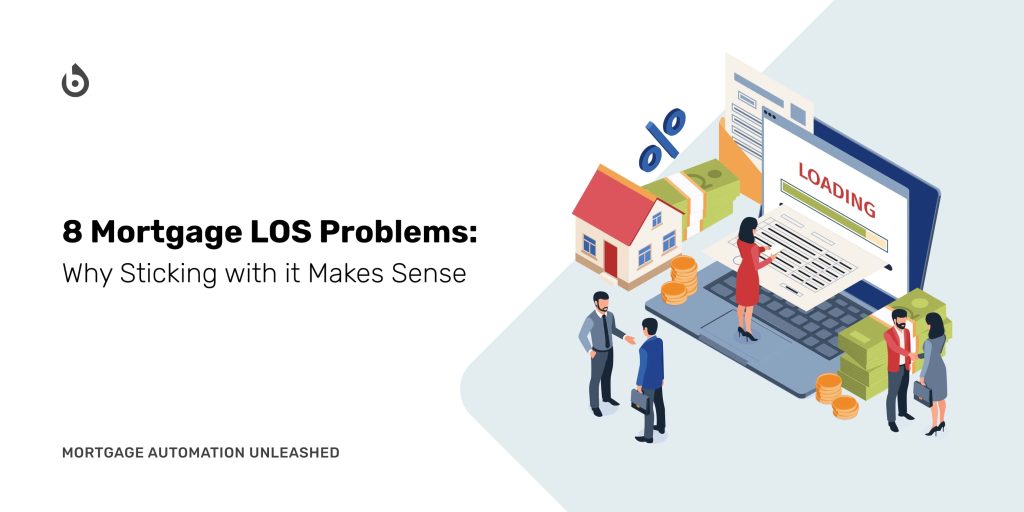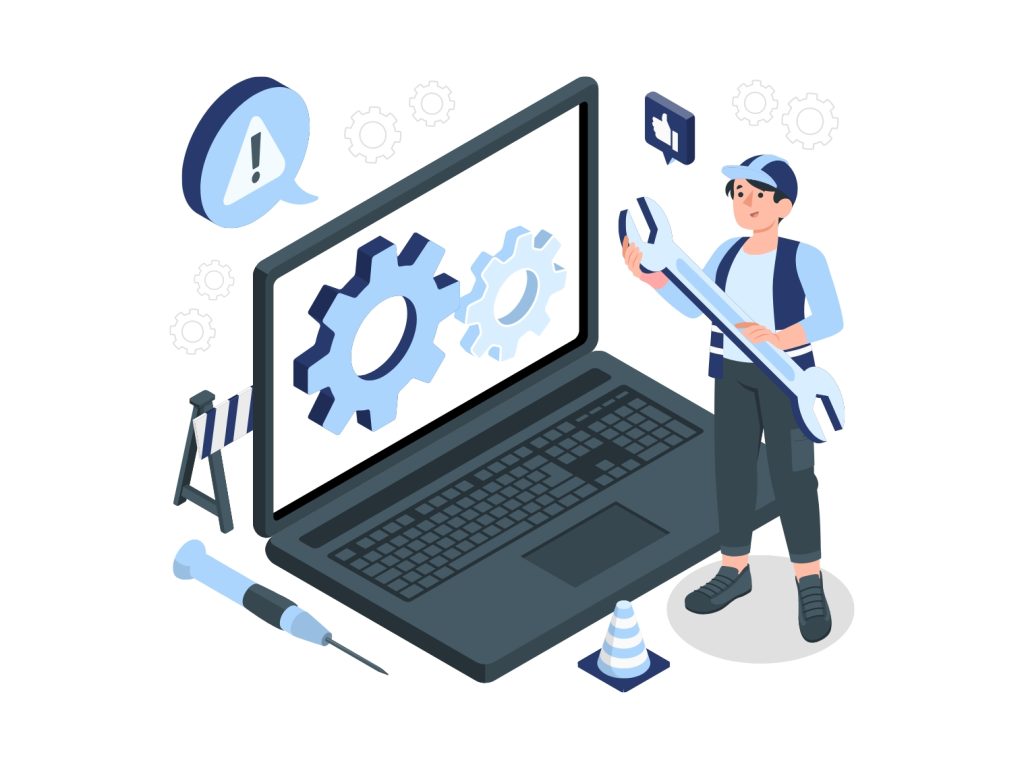August 8, 2023 | 8 min read
What's wrong with your LOS - Part II

Mario DiBenedetto
Managing Director

Based on our experience developing mortgage-related software for top 50 lenders for over 20 years, we know that all lenders suffer the same 8 challenges around their loan origination system, regardless of which system they are using. Our assertions are two-fold:
- First, it is highly unlikely that you will eliminate ANY of these 8 issues by changing your LOS. To be clear, we are not saying you can’t eliminate ALL 8, we are stating you will not eliminate ANY.
- Second, given the first assertion, your resources and energy are better served at “fixing” what you have.
This article is being separated as 3 different parts, Part I and Part II will review each of the 8 challenges in-depth and Part III will emphasize on why you should retain your LOS despite the problems being faced by the lenders. See if you can relate to how each of the issues manifests itself in your company and whether you have any confidence they will be eliminated.
5. Heavy vendor dependencies
Mortgage loan origination systems (LOS) are designed to streamline the mortgage lending process and ensure that loans are originated efficiently. However, these systems consistently fail to prevent poor quality loans from being originated. We have yet to meet a lender with zero loan defects and zero post-closing remediation. Similarly, we have yet to see a LOS that can guarantee zero defects. This is due to a variety of reasons:
Integration Challenges:
Mortgage LOS systems need to integrate with multiple third-party vendors for services such as credit checks, appraisals, title searches, and income verification. The complexity of integrating these disparate systems can lead to technical challenges, delays, and compatibility issues. Foremost amongst these issues is a sheer lack of appreciation for MISMO standards. Nearly every LOS vendor adopts a “close enough” strategy to mapping data into MISMO, resulting in countless scenarios where data is mapped, and, thus, passed along to other systems, incorrectly.
If you conduct a LOS RFP, ask each LOS vendor to provide the list of test scenarios they use to regression test each MISMO payload they receive or generate. Sure, you’ll get the same blank stare from your existing vendor, but that doesn’t make it right!

Lack of Control:

Relying on third-party vendors means that mortgage lenders have limited control over the performance and reliability of the vendor's services. If a vendor experiences downtime, service disruptions, or data breaches, it can directly impact the lender's ability to originate loans efficiently. Lenders may have to depend on the vendor's response time and resolution process, which can cause delays and affect customer satisfaction. When a lender has a limited set of vendors integrated into their LOS, the lender can be held captive by poor performing vendors. And when the vendor has to revenue share with the LOS provider, they are less likely to offer compensation for outages and disruptions.
Data Security and Privacy Risks:
Third-party vendors usually handle sensitive borrower data during the loan origination process. This introduces potential data security and privacy risks. If the vendor has inadequate security measures, data breaches, unauthorized access, or mishandling of personal information can occur. These incidents can have severe consequences, including financial losses, legal liabilities, regulatory penalties, and damage to the lender's reputation. Does your LOS vendor certify the data security policies and procedures of every vendor to which they integrate?

Limited Flexibility and Customization:
Mortgage lenders may have specific requirements or unique processes that they want to incorporate into their loan origination system. However, third-party vendors may have predefined workflows or limited flexibility to accommodate the lender's specific needs. This lack of customization options can restrict the lender's ability to optimize their processes, resulting in inefficiencies and suboptimal loan origination practices.
6. Undifferentiated
An undifferentiated mortgage loan origination system can have significant impacts on a lender in both up and down markets. In this context, undifferentiated means that the LOS is so lackluster (sometimes a factor of being outdated) that it offers little to no benefit over any other LOS. Here are the effects this can have:
Lack of Competitive Advantage:
In a competitive mortgage market, lenders strive to differentiate themselves by offering unique products, efficient processes, and excellent customer service. However, an undifferentiated loan origination system limits the lender's ability to stand out from the competition. Without innovative features or capabilities, lenders may struggle to attract borrowers and lose market share to competitors who offer more advanced and tailored loan origination experiences.

Reduced Efficiency and Increased Costs:

An undifferentiated system may lack automation, streamlined workflows, or integration capabilities with external systems, leading to manual processes, redundant data entry, and increased operational costs. Inefficiencies in the loan origination process can result in longer turnaround times, higher staffing requirements, and increased administrative burdens. These factors can erode profitability, especially during down markets when cost control becomes crucial.
Inability to Adapt to Market Changes:
Mortgage markets are dynamic, and borrower preferences, regulatory requirements, and market conditions can change rapidly. An undifferentiated loan origination system may lack the flexibility to adapt to these changes effectively. Lenders may struggle to introduce new loan products, comply with regulatory updates, or quickly respond to shifting borrower needs. This inflexibility can result in missed opportunities, increased compliance risks, and reduced responsiveness to market demands.
Poor Borrower Experience:

Borrowers expect a seamless and user-friendly loan origination process. An undifferentiated system may lack modern user interfaces, mobile capabilities, or self-service options that borrowers increasingly demand. This can result in a poor borrower experience, including confusing application processes, lack of transparency, and limited access to real-time information. Negative borrower experiences can damage the lender's reputation, reduce customer loyalty, and impact referrals and repeat business.
Limited Business Growth Opportunities:
An undifferentiated loan origination system can hinder a lender's ability to pursue growth opportunities. In up markets, when loan demand is high, lenders need scalable systems that can handle increased volumes efficiently. Without the necessary scalability and agility, lenders may struggle to capitalize on market opportunities, resulting in missed revenue potential and slower growth compared to competitors with more advanced systems.
7. Outdated technology
The impact of outdated technology on a mortgage lender can be significant and wide-ranging. This may seem like a repeat of the prior section because outdated technology can be a contributor to a lack of differentiation. But outdated technology can have its own set of insidious impacts.
I recognize that most lenders using outdated technology are doing so because of the direct cost economics. Here are some of the indirect costs you might experience if you’re using outdated technology:
Inefficiency and Increased Costs:
Outdated technology in loan origination systems often lacks modern automation, streamlined workflows, and integration capabilities. This can result in manual data entry, redundant processes, and the need for extensive manual workarounds. These inefficiencies increase operational costs, lengthen loan processing times, and hinder scalability. Lenders may need to allocate additional resources and staff to compensate for the system's limitations, reducing profitability and competitiveness. Not that by definition, if you are increasing the manual workarounds and redundant processes, you are creating an environment that can only scale up and down by adding/subtracting people.
Limited Functionality and Flexibility:
Outdated loan origination systems may lack critical functionalities necessary to meet evolving market demands and regulatory requirements. They may not support new loan products, have limited compliance features, or lack integration capabilities with external systems. This restricts the lender's ability to adapt to changing market conditions, offer innovative loan products, or meet borrowers' expectations.

Poor User Experience:

Outdated user interfaces and cumbersome workflows can create a poor user experience for loan officers, underwriters, and other staff members. Employees may struggle with complex navigation and limited reporting capabilities. This leads to reduced productivity, increased frustration, and potential turnover of skilled personnel. A negative user experience can also impact employee morale and motivation, further affecting overall operational efficiency.
Data Security and Compliance Risks:
Outdated loan origination systems may lack robust security measures and fail to meet current compliance standards. This puts the lender at risk of data breaches, unauthorized access, or non-compliance with industry regulations. Inadequate data security can result in financial losses, legal liabilities, reputational damage, and regulatory penalties. Staying up-to-date with security and compliance requirements is crucial in the mortgage industry, and outdated technology may pose significant risks in this regard.
Missed Business Opportunities:
Outdated loan origination systems can hinder lenders' ability to capitalize on market opportunities and adapt to industry trends. They may lack integration capabilities with emerging technologies, such as artificial intelligence, machine learning, or data analytics. These technologies can provide valuable insights, improve decision-making, and enhance customer experiences. Without access to these capabilities, lenders may miss out on potential revenue growth, lose market share to more technologically advanced competitors, and struggle to stay relevant in a rapidly evolving industry.

Difficulty in System Upgrades/Maintenance:

Outdated loan origination systems often have outdated underlying technologies and may not be easily upgradable or compatible with newer software versions. This can make system upgrades and maintenance time-consuming, costly, and disruptive. Lenders may face challenges in implementing necessary system enhancements, resolving bugs or security vulnerabilities, and integrating with new platforms or service providers.
Further, some LOSs only support certain browsers and even certain operating systems. These limitations put a burden on your technology team to “make due” and find a way to make everything else work around the LOS.
8. Not scalable
A non-scalable loan origination system is one where the system either slows down, crashes, or misbehaves as higher loan volumes are put through it. In our current market situation, you may not consider this a near-term concern. But, more than likely, you feel this in a smaller way every month-end when the number of closings increase.
Besides the obvious problems of slow-downs and crashes, here are some other effects a non-scalable LOS might be having on your organization:
Hindered Growth and Missed Opportunities:
A non-scalable loan origination system can impede a lender's ability to seize growth opportunities. In a competitive mortgage market, lenders need the capability to handle increased loan volumes efficiently. If the system cannot scale to accommodate business growth, lenders may face limitations in expanding their operations, offering new loan products, or capitalizing on market demand. This can result in missed revenue opportunities, loss of market share, and reduced competitiveness.
Poor Borrower Experience:
A non-scalable system can have a direct impact on the borrower experience. Increased loan processing times, delays in communication, or system outages can frustrate borrowers and erode their trust in the lender. Borrowers expect timely updates, quick responses to inquiries, and a seamless loan origination process. If the system cannot scale to meet these expectations, borrowers may seek alternative lenders who can provide a more efficient and responsive experience.
Increased Maintenance and Upgrade Costs:
As technology evolves, outdated and non-scalable loan origination systems may require extensive maintenance and costly upgrades to keep pace with industry advancements. The lack of scalability can make system upgrades complex and time-consuming, requiring significant investment of time, resources, and financial resources. The costs associated with maintaining and upgrading a non-scalable system can strain the lender's budget and divert resources that could be invested in more strategic initiatives.


